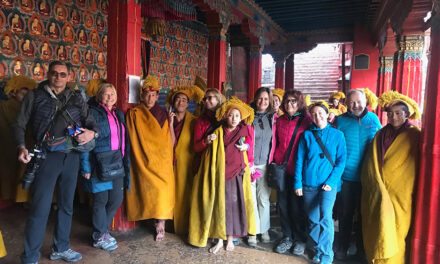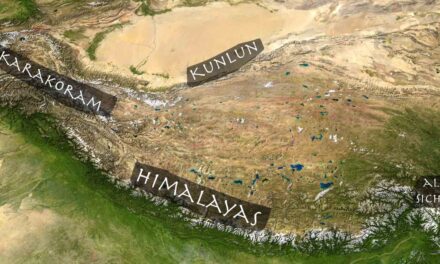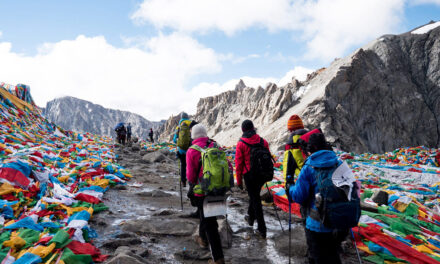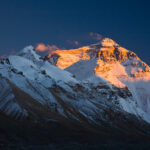When it comes to travel to Tibet, high altitude sickness or mountain sickness can affect your holiday in Tibet. Therefore, a better understanding of changes in both geographical terms and your body in the high altitude of Tibet is of utmost importance before planning for your journey to Tibet.
In this series of posts, I will be writing all the required information about high altitude and its effects on travellers’ bodies during your Tibet tour.
Upon your arrival in Tibet, there will be a tremendous gain in altitude from the sea level. Here air becomes thinner, leading to barometric pressure falls due to the lesser oxygen available in the atmosphere. The lesser amount of oxygen in Tibet will cause some maladjustment in travellers bodies called high altitude sickness. The process of gradually adapting to the high altitude of Tibet is called acclimatisation.
Example of adapting to the high altitude of Tibet
The acclimatisation or process of adapting to the high altitude of Tibet is best to explain in this example.
Imagine you are travelling in a modern pressurised aeroplane flying at an altitude of 29,000 feet (8800 metres). If the cabin loses its pressure suddenly, everyone will lose consciousness and die unless breathing on supplemental oxygen within five minutes.
Yet, at the same altitude, many mountaineers have climbed Mount Everest without oxygen supplements. In these two scenarios, the difference is a gradual process in the body called acclimatisation.
In acclimatisation, your body slowly gets used to lower levels of oxygen in the air. Individuals with adequate acclimatisation can climb altitude as Everest unassisted and survive for a short period.
What happens to the human body as it gets less oxygen
Our human body adapts to increasingly thin air and delivers the necessary amounts of oxygen to cells due to acclimatisation. This process could take over a period of days to weeks.
There is a massive difference in the acclimatisation duration between you, born and raised at sea level, and your tour guide born and raised in Tibet. If you live at a bit lower altitude at about 5000 feet (1520 metres), you will find yourself more tolerant of high altitude than other group members from lower areas.
An Analogy to help understand the process of adapting to the high altitude of Tibet
The analogy here will help you understand the process of adapting to the high altitude of Tibet.
Imagine a train delivery system. Your blood vessels as the Railway line over the train (blood) moves with energy from its locomotive (heart) and boxcars ( Your red blood cell) carrying the precious cargo (Oxygen).
The train is fill with cargo by loader ( Your lungs) and empties its load at the factory ( Muscles, Heart, Brain and other tissues), where the shipment is require. At the loader, not all the cargo arrive loaded at any one time. Much of the cargos are sent back to come again to the loader.
As individual travellers gain altitude, lesser and lesser cargo (oxygen) arrives at the loader (lung) each minute, yet the demand of the factory (Body) remain constant. So your body will respond by increasing the loaders (Lung breathe faster) speed, increasing the speed of the train ( making heartbeat quicker), and increasing the number of boxcars ( making more red blood cells).
In this post, we will discuss this process in detail.
Breathing adaptation to the high altitude of Tibet
The most noticeable changes to your body during adaptation to high altitude are breathing more often. For example, when you are drinking from a water bottle, you will have to stop in the middle to take a breath, or you may need to stop in the middle of the conversation to take a breath. In general, you will breathe more in Tibet either during activity or while resting.
Each individual responds differently to the low oxygen of high altitude. Some may need to breathe more often than others actively. Using our train analogy, If there is less oxygen in the loader (your lungs), you will have to make the loader work faster to get the required amount of oxygen.
Taking sleeping pills can decrease your capacity to make the lung breathe faster, and Drugs like acetazolamide can increase by signalling the lung to work more quickly. Similarly, some people can advise using a different technique to increase the breathing rate by simply breathing more. Whether consciously or not, it is an essential factor.
Most world-class climbers increase their breathing at altitude more than superb marathon runners. The psychological of travellers can factor in their capacity to breathe at high altitudes. The first to people to summit Everest without oxygen supplement provides an excellent example. One has a brisk rapid breathing response to altitude, while the other doesn’t.
Increase Pulse
As you traveller higher in Tibet, just as your respiration increase, your pulse also increase during the initial days. If there is lesser oxygen in each boxcar (Red Blood cells), then the train’s locomotive (heart) will have to go faster to deliver the same amount of oxygen to the factory as before.
It is an excellent idea to check your pulse rate every day in Tibet when resting and relaxing at an altitude destination. Of course, checking your pulse immediately after awakening up in the morning is best. Yet you can also take it before bed at night.
As you are more acclimatised, you will notice the drops of your pulse and pounding in your chest. It can be a sign that your body is responding positively to altitude. However, medicine for high blood pressure or angina could limit this response. Hence in such a case, checking your pulse will not be a useful way to judge what is happening to your body.
Urinary response
In Tibet, you will observe that you have to urinate more often than usual due to diuresis. If the train represents your blood, diuresis means getting rid of non-cargo carrying cars like empty flatbeds. Diuresis occurs when you are sleeping at 10,000 feet (3050 meters) and higher.
When it happens, you will have to get up one-two time in the night to urinate, and you could lose up to 2 per cent of your body fluids. Therefore, if such happen, be more cautious of high altitude sickness. It means you are more susceptible to altitude illness.
Blood Response
Our blood thickens in altitude. Initially, blood gets thicker in the first few days due to diuresis and associated fluid loss. Later it becomes more viscous as our body makes more red blood cells to carry oxygen.
Using the train analogy again. It can take more cargo (oxygen) if the train adds more boxcars ( red blood cells). Yet, it could be a problem if there are too many only carrying a small payload. Then, the train (blood) will become heavy and cant travel efficiently or fast. Your blood will become too thick.
It’s easier for thick blood to clot and cause problems in delivering oxygen where it is necessary. In addition, inactivities like being confine in a tent for days can increase the risk of developing a clot that could migrate.
For example, blood clots in the leg can migrate to the lungs and become life-threatening. Migrating clots may be a more common problem than previously thought and could explain the sudden, rapid deterioration of people high up in the mountains. It is recommend to force yourself to exercise if caught in such a situation.
It is recommend that aspirin make blood less sticky and less likely to clot. Yet, there are no studies of this at altitude. In addition, sometimes thinning blood could lead to increased bleeding from Injuries and stomach ulcers.
Opinion on if people should take aspirin at altitude is divide. It makes sense for travellers spending a relative amount of time at the extreme altitude above 18,000 feet or 5490 meters. Yet its effectiveness is not for sure.
I also recommend aspirin for people who will spend more than a week in Tibet, especially if you are facing a period of inactivity. Suppose you decide to take aspirin. A one 325 mg tablet every other day is probably adequate.
Change during sleep
Most people will face difficulty sleeping at an altitude. As a result, sleep may be irregular, and some travellers may wake up in the middle of the night for breathlessness at an altitude above 8000 feet, 2440 meters. Sleep irregularities are typical at an altitude above 15,000 feet ( 4570 meters).
You will hear your travel companion’s breathing increase and becoming loud in the Tent hostel at Everest basecamp, decrease after a minute or two, become almost imperceptible and then start up again. This pattern is call as periodic breathing. Sometimes before breathing resumes again, the sleeper may awake, startled.
During the initial phase of rapid breathing, the body builds up oxygen in the brain, and the need to breathe diminishes. Then just as the breathing becomes almost invisible, the brain starves oxygen and wakes up to breathe!
Periodically breathing often makes travellers anxious, and some may wish to abandon their trip. However, it is normal and diminishes with acclimatisation over time.
Don’t take a sleeping pill, sedatives and tranquilliser. These drugs will make you breathe less, and as a result, less oxygen is deliver to tissue, and it is not a desirable state of affairs.
High Altitude Deterioration
Our human body doesn’t adapt well above 16500 feet (5030 meters). The longer you stay in such altitude, the more you will be physically, mentally and emotionally deteriorate. So people don’t permanently live above 5030 meters above sea level for an extended period.
Optimum Period for Acclimatisation
Acclimatisation to avoid acute mountain sickness takes less time than acclimatisation for maximising performance in altitude. Hence Mountaineers usually take weeks to get use to Tibet’s thin air, while regular tourists in Tibet would take three to four days to acclimatise to Tibet.
There is no fast formula for the best ways of acclimatisation. This process varies with each person for every exposure. One suggested way to avoid altitude sickness is to increase the sleeping altitude by 300 meters. While ascending higher, it is ideal for taking a break every two to three days by sleeping at the same altitude as the previous day.
If you are visiting Tibet as a usual traveller, it is ideal to arrive in Lhasa a day or two before your actual tour date. So you can relax for these two days before the beginning of the actual guided tour. But, unfortunately, not many travel agencies can offer free days in Lhasa for acclimatisation. But we often keep it to all the tours.
Follow the rule of climb high and sleep now, model. In the day, you will have to climb as high as you can, yet sleep at the same or slight higher elevation than the night before. Don’t overexert in the first few days.
Trial and error is the best way to discover your pace for adapting to the high altitude of Tibet.
Conclusion of adapting to the high altitude of Tibet
This is the first post in the series of posts about altitude illness. We hope all the information post here under this tag would help plan your Tibet travel.
All the information on this post is base on my learning and experience organising international tours to Tibet for two decades. If you would like to learn more about Tibet travel information, Tibetan Culture, and other information on Tibet. Please do write to me at [email protected]














